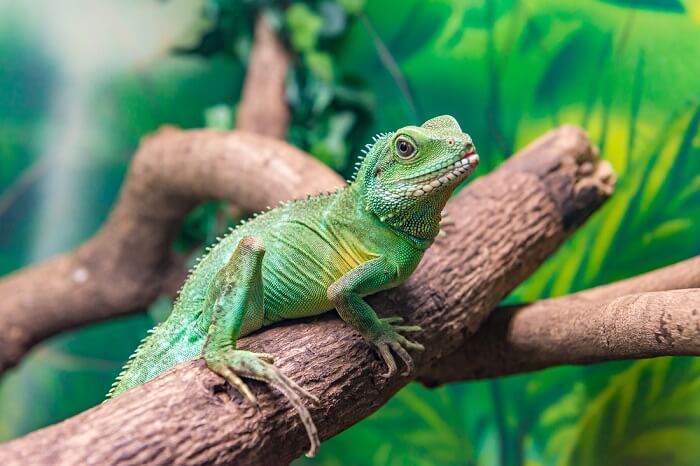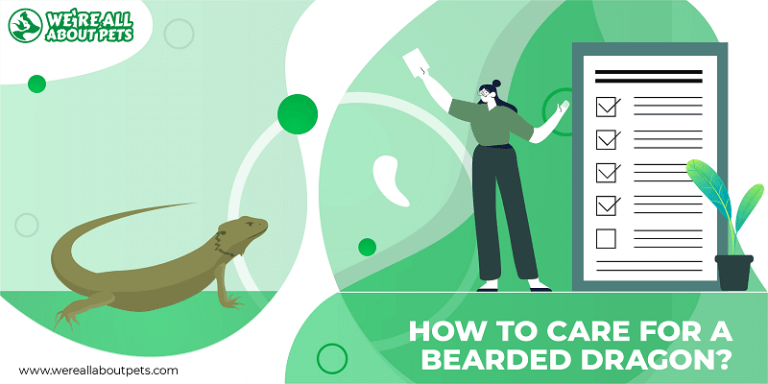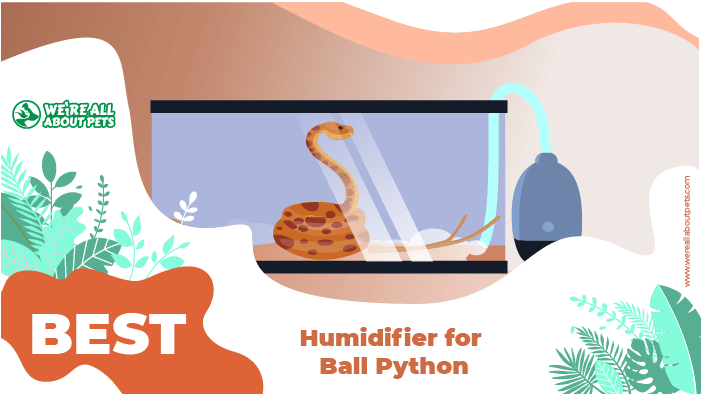American Green Tree Frog: Care, Temperament And Diet
This page contains affiliate links. We may earn money or products from the companies mentioned in this post through our independently chosen links, which earn us a commission. Learn More
American green tree frogs can make good pets and be a great deal of fun to have in your home. In terms of care, they are an easy to medium level of difficulty for amphibians. They’re also some of the most active and interesting amphibians in the pet trade. This article will help you understand their special needs and decide if they’re the right pet for you.
Care
The care of an amphibian includes providing the right enclosure. It needs the proper temperature, lighting, humidity, substrate, and size. Good care also involves feeding the proper diet. American tree frogs can live 5-8 years in captivity with good care.
Good care should create conditions close to what they encounter in the wild, since they’re well adapted to that world. In the case of American green tree frogs, think of the Southeastern United States, where they reside near swamps, ponds and small streams. For more information about their wild habitats.
It’s important to choose a captive-bred animal for your pet. Taking a frog from the wild is illegal in many places, and it’s bad for the ecosystem. Additionally, it can introduce disease from the wild into other animals in your home. One of the most serious concerns is Chytridiomycosis.
Cage Size
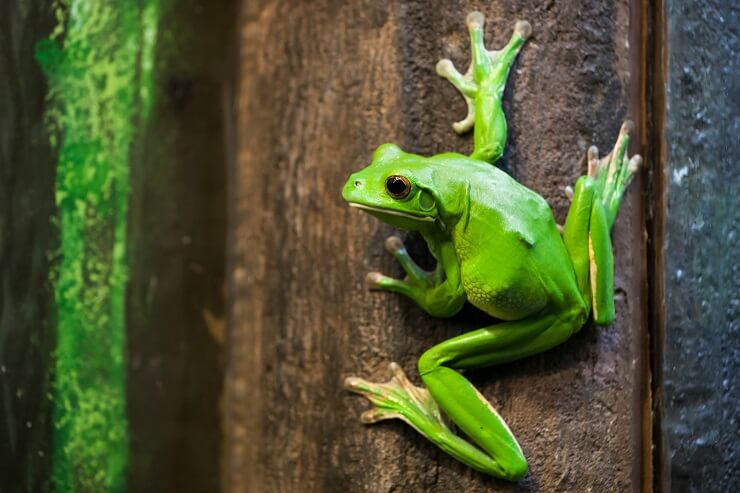
Adult American green tree frogs can be 2 ½ inches long. As their name implies, they’re tree-dwelling (arboreal) animals, so the cage should be taller than it is wide to allow vertical movement.
The cage should be the equivalent of at least a 10-gallon aquarium, but slightly larger is better. A cage that size can be home to 3 frogs and one the equivalent to a 20-gallon may house 5-7 frogs, depending on how it’s set up.
Substrate
Enclosures should have a substrate that allows natural behaviors. For the bottom of the cage, it’s best to use 2-3 inches of sterile potting soil or coconut fiber on top of 1-2 inches of pebbles. The pebbles should be large enough to deter swallowing.
For variety, the pebbles can extend up to the surface in some areas. On top of the soil and coconut fiber, a thin layer of sphagnum moss will help maintain the high humidity required in the enclosure. The moss should be changed regularly to avoid the growth of mold.
In the vertical space, branches should be provided for climbing. Moss and plant matter can be added to the branches to help keep humidity levels up and provide hiding areas for security.
The branches need to extend the vertical space all the way to the basking area and UV lighting. Live plants are best for maintaining a healthy habitat, but if you’re not good at keeping plants alive, then you can use artificial plants.
Temperature
Enclosures should have a temperature range between 70 and 75 F, with a basking area that stays between 75 and 82F. Much higher than that temperature range can cause heat stress.
A weak heat lamp can provide the needed heat source. Make sure that the lamp is above the level that would allow direct contact.
Lighting
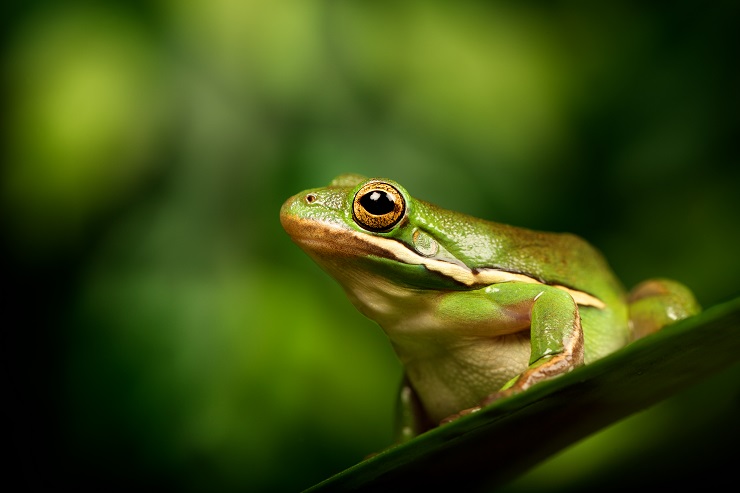
Though there’s not a documented need for UV lighting in this species, it may be beneficial. A low-intensity UV light may be provided for 12 hours a day.
Be aware that the UV spectrum wanes long before the light burns out, so it should be replaced every 6 months. If you choose to add UV lighting, lights with similar intensity to those for Leopard geckoes may be used. For recommendations, see our related article best lights for leopard geckos.
Humidity
The humidity in the enclosure should be high: 60-85%. Be sure to use a hygrometer to measure the humidity in the enclosure. It’s difficult to maintain that level of humidity in most enclosures, so the use of a misting system is highly recommended. For more information on humidifiers, see our article best humidifiers for reptiles.
With humidity at this level, it’s important to clean the cage regularly and change substrate to avoid the growth of molds and bacteria that can cause respiratory and skin disease.
With amphibians, it’s important to use water that has been treated to remove chlorine, chloramine and other potential contaminants. Using reverse-osmosis water is another good option.
Diet
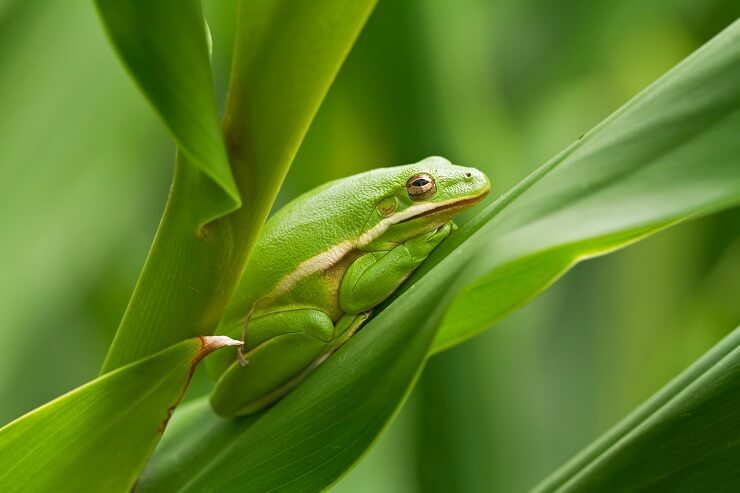
American tree frogs in the wild feed on insects and other small invertebrate prey items.
They should never be given foods designed for other animals.
Mealworms, crickets, earthworms, fruit flies, houseflies and moths are all good choices for food items. They should be fed good quality vegetables and a calcium supplement for several days prior to being offered. Additionally, they should be dusted with a calcium supplement (without D3) when fed to your pet.
Insects and invertebrates have higher phosphorus than calcium, and the dusting gets that back to a positive ration that’s important for proper utilization of calcium.
Weekly, the calcium supplement can be replaced by a multi-vitamin supplement. The vitamin supplement may contain D3. Young animals should be fed daily, but as the frog matures and growth slows, the insects should be offered 3-4 times per week.
Water should be available in the enclosure and should be cleaned and replaced daily. Use water free of any contaminants for the drinking water, just like mentioned for the humidifier above. For good enrichment, a system that recirculates the water into a waterfall or rain feature is a great addition to the enclosure.
Temperament
American tree frogs don’t enjoy being handled and it will cause them stress. Additionally, their skin is very sensitive and permeable. Oils from your skin can cause damage to them easily. Toxins on your hands, like nicotine on a smoker’s hands, can cause serious health problems for frogs.
Male frogs can be quite loud during breeding season, so be prepared to deal with loud nighttime croaking.
Health Concerns
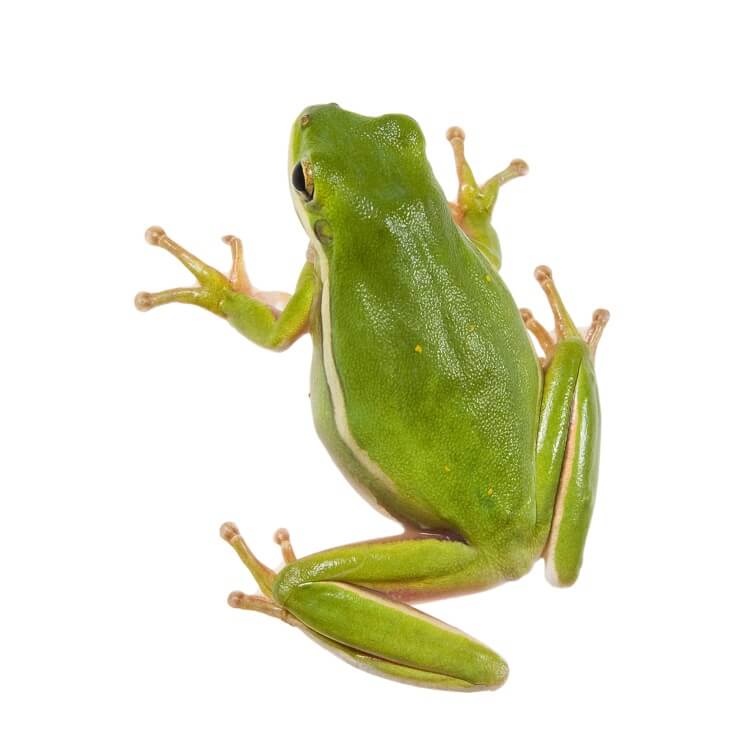
All amphibians should be seen regularly by a veterinarian. The most common health concerns that you may see include:
- Nutritional deficiencies
- Fungal or bacterial skin infections
- Abscesses
- Parasites
- Chytrid fungus
- Sepsis (“red leg”)
It’s also good to get an annual health exam for your frogs. If you need to find an experienced reptile and amphibian veterinarian, start your search here.
Summary
American tree frogs can be great pets for someone willing to make the commitment to the care they require. They are beautiful and interesting frogs.
Frequently Asked Questions
Are American green tree frogs poisonous?
Almost all amphibians produce toxins, but American tree frogs produce them at very low levels, so they aren’t a concern for humans.
Can you touch a green tree frog?
It’s not toxic for you but touching a tree frog can be harmful for them. Their skin is highly permeable and sensitive. Toxins can get across their skin and the oils on you hand can damge their protective coating.
What do green tree frogs eat?
They exclusively eat insects. See the diet section above for specific recommendations.
Are green tree frogs invasive?
They’re native to the Southeastern United States and the range extends into Virginia to the north and Texas to the west. Outside that are, they are invasive. However, even within that region, moving a frog from one area to another or releasing captive frogs can spread disease to wild populations.

